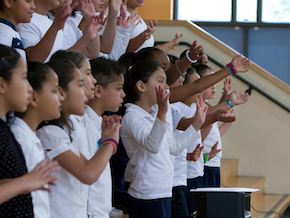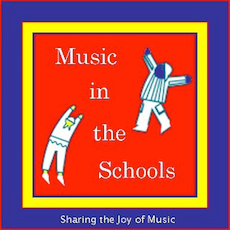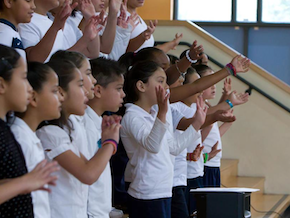
Cuts in music programs in California public schools are old news, and yellow news at that. Indeed, the news was scandalous in 2004 when the Music for All Foundation released its report, Sounds of Silence: The Unprecedented Decline of Music Education in California Public Schools. The report cited a 50 percent decline in involvement in music education between 1999 and 2004, and noted that then Governor Schwarzenegger was proposing that high school students be allowed to graduate with no music education at all.
The new news, which is still a few years old, is that nothing has changed and in some places the funding situation is worse. According to studies collected by the California Alliance of Arts Education these things are true:
• In 2000, more than one million students were enrolled in school music programs. By 2008, that number had dropped by 57% to 470,000.
• In 2009, 60% of districts surveyed by the Legislative Analysts Office had shifted Arts and Music Block Grant funds away from arts and music programs; 20% of those districts cut programs altogether.
• African American and Latino students are impacted disproportionately by declines (during this same period). There has been a 49% drop among African Americans and 40% drop among Latinos.
It’s also old news that music education, beyond its intrinsic qualities can also lead to smarter and more successful students. That was not really news in the mid-1990s. Some might even argue that that hasn’t been news since the mid-1920s, with the advent of work by among others Carl Orff, Rudolph Steiner, and Zoltán Kodály.
And Now a Word From the Private Sector
As a result of all these cuts, the private sector has appeared from time to time to fill a void where it can. Last week we looked at Palo Alto High School, which has more music opportunities than many private high schools — thanks to parents, administrators, and advocates who, when faced with cuts, said, in effect, “not in my backyard.”
This week we look at a privately funded music program that is starting to make a difference in East Palo Alto.
As an aside it’s interesting to note that private sector help is sometimes a sore point even among advocates. In an effort to track down recent statistics regarding music programs we stumbled into the digital office of Lora Bodmer, director of public relations and social media at NAMM, the trade association of the International Music Products Industry. When we explained we were writing a piece about a small private sector effort to help fill the void in music education she was momentarily put off. “Well, yes every little bit helps,” she said, “but of course we would like to see all children benefit.”
As if to imply that any effort not focused on changing the whole system is somehow less. While children in the middle schools that feed Palo Alto High and Gunn High have tremendous opportunities to look forward to, the children in East Palo don’t. They’re largely Latino and African American and live on the economic outskirts of Silicon Valley. And because the requirement for entry into virtually any California public high school music program is that you must have mastered rudimentary music skills they’re out of luck.

In 1995, the Palo Alto branch of the Music Teachers Association of California broke off and reconstituted itself as the Music in the Schools Foundation (MIS). The organization, a 501C3, now sustains four teachers providing a variety of music instruction to kids, Kindergarten to Fifth grade in three schools in the Ravenswood School District. The schools are Willow Oaks Elementary School in Menlo Park; the Green Oaks Elementary School in East Palo Alto, and Los Robles, a dual Immersion Magnet Academy also in East Palo Alto. Nearly 1450 students are served, which is roughly 30 percent of the entire student population of the Ravenswood school district. “I believe we can have a similar effect to El Sistema,” says Jason Fong, an MIS Advisory board member, referring to the Venezuelan music education effort that began in 1975 and serves primarily low-income students. El Sistema has been made famous in this country, and particularly California, by the conductor of the Los Angeles Symphony, Gustavo Dudamel, himself a product of the program.
El Sistema was pioneered by the economist and musician Jose Antonio Abreu, who was once quoted to say, "Music has to be recognized as an agent of social development, in the highest sense because it transmits the highest values - solidarity, harmony, mutual compassion. And it has the ability to unite an entire community, and to express sublime feelings."
The MIS Foundation provides the Ravenswood school district with free classes in which students learn music and rhythm notation. Younger children get to sing, dance and play music games. Older students play the recorder and learn basic instrumental skills. Programs include an after school strings program in which the instrument are provided at no cost.
From Music to Critical Thinking
“What we’ve seen happen,” says Kay Kleinerman, an MIS board member, “is how music education and participation foster critical thinking skills. It’s not that they can’t learn those skills in other disciplines but in music you learn how to call on your imagination. Children learn how to use their voices in very creative ways, they learn to experiment, and they begin to get a sense of how they sound and who they are.”
Kleinerman, who serves on the faculty of both Notre Dame de Namur University in Belmont and Sofia University in Palo Alto, adds, “We don’t promote music in the schools merely because we want to raise test scores, although that certainly is often one byproduct, but we do it because we believe every child deserves a music education, every child deserves that joy and the chance to authentically express themselves.
“As a teacher I’ve witnessed children being exposed to other languages and cultures and how that broadens their experience and how that encourages their curiosity, which is the beginning of creativity. Of course they’re not aware of it but really what they’re learning is intellectual flexibility.”
MIS, which recently has attracted financial support from the Johnson Family Foundation, is hoping to expand to middle schools throughout the Ravenswood District and then beyond. It’s also hoping to find a choir teacher.
“The drop out rate is greater than 50 percent in this school district,” notes Fong, who is from Palo Alto. “These kids just can’t compete with those from the other Palo Alto. But this is where MIS has a big role to play. If, for example, we can help kids get into bands, orchestras and ensembles they’ll have a reason to stay in high school. They’ll have a reason to succeed. That’s really what we’re about.”

